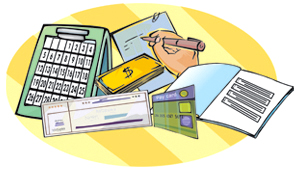Payroll Accounting: Terms and Records
 Payroll: A payroll includes a list of employees and payments due to each employee for a specific pay period.
Payroll: A payroll includes a list of employees and payments due to each employee for a specific pay period.
Pay Period: A pay period is the period for which an employee is paid.
Payroll expense: The payroll expense is the largest expense for most companies. To calculate salary expenses, businesses set up and use weekly, biweekly, or monthly pay periods.
Paycheck: A paycheck is a paper document issued by an employer to pay an employee for services rendered. Many companies now also offer direct deposit, where the physical check is replaced by an electronic deposit to the employee’s bank account.
Pay stub: Also called a pay slip, payslip, pay advice, or a paycheck stub, this is a document that an employee receives either along with their check or with the reciept of the direct deposit transaction. It will typically detail the gross income, taxes, and any other deductions such as retirement plan contributions, insurances, garnishments, or charitable contributions. The deductions are subtracted from the gross amount to arrive at the final net amount of the pay. The pay stub may also include the year-to-date totals.
Payroll card: A payroll card is a card that allows an employee to access their paycheck by using a card that looks like a bank debit card. A payroll card is more convenient than using a check, as it can be used either at any participating automatic teller machine to withdraw cash, or in retail environments to make purchases; sometimes payroll cards are even less expensive than the payday loans available at retail check cashing stores. Most payroll cards charge a fee if used at an ATM more than once per pay period.
The payroll card account is usually held as a single account in the employer's name. That account holds the payroll funds for all employees using the payroll card system. Some payroll card programs establish a separate account for each employee.